Reduction oxidation - Study guides, Class notes & Summaries
Looking for the best study guides, study notes and summaries about Reduction oxidation? On this page you'll find 2770 study documents about Reduction oxidation.
Page 2 out of 2.770 results
Sort by
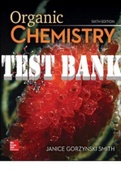
-
TEST BANK for Organic Chemistry 6th Edition by Janice Smith. ISBN-13 978-1260565843. Complete Chapters 1-29 in 1439 Pages.
- Exam (elaborations) • 1439 pages • 2023
-
- $33.16
- 3x sold
- + learn more
Organic Chemistry 6th Edition by Janice Smith. ISBN-10 X, ISBN-13 978-3. Complete Chapters 1-29 in 1439 Pages. TEST BANK. TABLE OF CONTENTS Chapter 1 Structure and Bonding Chap ter 2 Acids and Bases Chapter 3 Introduction to Organic Molecules and Functional Groups Chapter 4 Alkanes Chapter 5 Stereochemistry Chapter 6 Understanding Organic Reactions Chapter 7 Alkyl Halides and Nucleophilic Substitution Chapter 8 Alkyl Halides and Elimination Reactions Chapter 9 Alcohols, Ethers, and Related Compo...
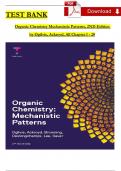
-
Ogilvie, Organic Chemistry Mechanistic Patterns, 2nd Edition TEST BANK by Ogilvie, Ackroyd, All Chapters 1 - 20, Complete Newest Version
- Exam (elaborations) • 410 pages • 2024
-
- $17.99
- 1x sold
- + learn more
Ogilvie, Organic Chemistry Mechanistic Patterns, 2nd Edition TEST BANK by Ogilvie, Ackroyd, All Chapters 1 - 20, Complete Newest Version CHAPTER 1 Carbon and Its Compounds 2. CHAPTER 2 Anatomy of an Organic Molecule 3. CHAPTER 3 Molecules in Motion: Conformations by Rotations 4. CHAPTER 4 Stereochemistry: Three-Dimensional Structure in Molecules 5. CHAPTER 5 Organic Reaction Mechanism: Using Curved Arrows to Analyze Reaction Mechanisms 6. CHAPTER 6 Acids and Bases 7. CHAPTER 7 π Bonds...
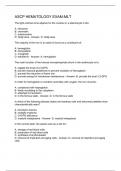
-
ASCP Hematology Exam-MLT
- Exam (elaborations) • 12 pages • 2024
-
- $12.99
- 1x sold
- + learn more
The light-colored zone adjacent to the nucleus in a plasmacyte is the: A. ribosome B. chromatin C. mitochondria D. Golgi area - Answer- D. Golgi area The majority of the iron in an adult is found as a constituent of: A. hemoglobin B. hemosiderin C. myoglobin D. transferrin - Answer- A. hemoglobin The main function of the hexose monophosphate shunt in the erythrocyte is to: A. reglate the level of 2,3-DPG B. provide reduced glutathione to prevent oxidation of hemoglobin C. ...
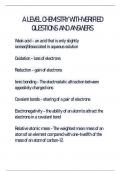
-
A LEVEL CHEMISTRY WITH VERIFIED QUESTIONS AND ANSWERS Weak acid - an acid that is only slightly ionised/dissociated in aqueous solution Oxidation - loss of electrons Reduction - gain of electrons Ionic bonding - The electrostatic attraction between op
- Exam (elaborations) • 9 pages • 2024
-
Available in package deal
-
- $19.99
- + learn more
A LEVEL CHEMISTRY WITH VERIFIED QUESTIONS AND ANSWERS Weak acid - an acid that is only slightly ionised/dissociated in aqueous solution Oxidation - loss of electrons Reduction - gain of electrons Ionic bonding - The electrostatic attraction between oppositely charged ions Covalent bonds - sharing of a pair of electrons Electronegativity - the ability of an atom to attract the electrons in a covalent bond Relative atomic mass - The weighted mean mass of an atom of an element ...
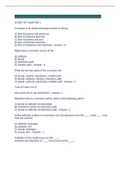
-
NACE CP2 - EXAM (2) QUESTIONS AND ANSWERS 2022
- Exam (elaborations) • 89 pages • 2022
-
- $15.49
- 16x sold
- + learn more
Corrosion is an electrochemical process involving A) flow of protons and electrons B) flow of neutrons and ions C) flow of protons and ions D) flow of electrons and ions E) flow of resistance and resistivity - Answer - d Metal loss or corrosion occurs at the A) cathode B) anode C) electronic path D) metallic path - Answer - b What are the four parts of the corrosion cell A) anode, resistor, electrolyte, metallic path B) anode, cathode, electron, electronic path C) anode...

-
Btec Applied Science Unit 13 Assignment B (Full Assignment)
- Essay • 11 pages • 2023
-
Available in package deal
-
- $11.94
- 6x sold
- + learn more
This is Btec Applied Science Unit 13 Assignment B (Redox for industry) which was awarded a distinction and contains all the practical results. This is an example of a Distinction level assignment, and you may use it as a guide to help you achieve a distinction and finish this assignment.
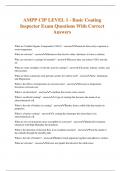
-
AMPP CIP LEVEL 1 - Basic Coating Inspector Exam Questions With Correct Answers
- Exam (elaborations) • 30 pages • 2024
-
- $14.49
- 1x sold
- + learn more
AMPP CIP LEVEL 1 - Basic Coating Inspector Exam Questions With Correct Answers What are Volatile Organic Compounds (VOCs)? - answerChemicals that easily evaporate at room temperature. What are solvents? - answerSubstances that dissolve other substances to form a solution. Why can solvents in coatings be harmful? - answerBecause they can release VOCs into the air. What are some examples of solvents used in coatings? - answerAcetone, toluene, xylene, and ethyl acetate. What are three com...
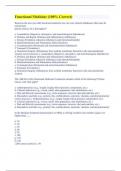
-
Functional Medicine (100% Correct)
- Exam (elaborations) • 14 pages • 2023
-
Available in package deal
-
- $11.19
- 1x sold
- + learn more
Based on the new (not old) functional medicine tree, the core clinical imbalances that must be restored are (please choose ALL that apply)* a. Assimilation (Digestive, absorptive, and microbiological imbalances) b. Defense and Repair (Immune and inflammatory imbalances) c. Energy (Oxidation-reduction imbalances and mitochondropathy) d. Biotransformation and Elimination (Detoxification) e. Communication (Hormonal and neurotransmitter imbalances) f. Transport (Circulatory) g. Structural ...
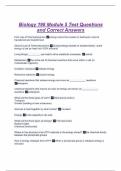
-
Biology 198 Module 5 Test Questions and Correct Answers
- Exam (elaborations) • 6 pages • 2024
-
Available in package deal
-
- $8.99
- 1x sold
- + learn more
First Law of Thermodynamics energy cannot be created or destroyed, only be transferred and transformed Second Law of Thermodynamics During energy transfer or transformation, some energy is lost as heat (not 100% efficient) Living things _________ use heat to drive metabolic processes. cannot Metabolism the entire set of chemical reactions that occur within a cell (or multicellular organism) Oxidation reactions release energy Reduction reactions require energy Chemical reactions that releas...
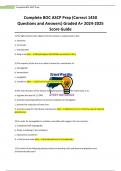
-
Complete BOC ASCP Prep (Correct 1450 Questions and Answers) Graded A+ 2024-2025 Score Guide
- Exam (elaborations) • 346 pages • 2024
-
Available in package deal
-
- $17.50
- 1x sold
- + learn more
Complete BOC ASCP Prep (Correct 1450 Questions and Answers) Graded A+ Score Guide 1) The light-colored zone adjacent to the nucleus in a plasmacyte is the: a. ribosome b. chromatin c. mitochondria d. Golgi area (Ans: - d (Morphological identifiable perinuclear halo.) 3) The majority of the iron in an adult is found as a constituent of: a. hemoglobin b. hemosiderin c. myoglobin d. transferrin (Ans: - a (2/3 iron in body bound to Hgb.) 4) The main function of the hexose monophospha...

How much did you already spend on Stuvia? Imagine there are plenty more of you out there paying for study notes, but this time YOU are the seller. Ka-ching! Discover all about earning on Stuvia


